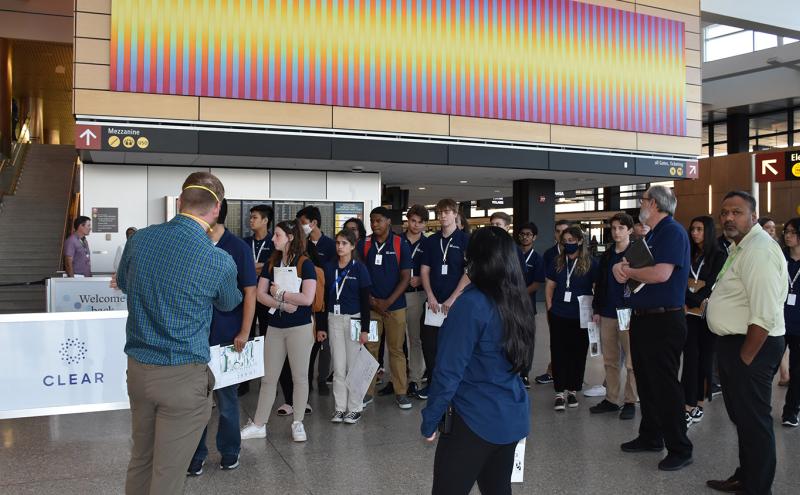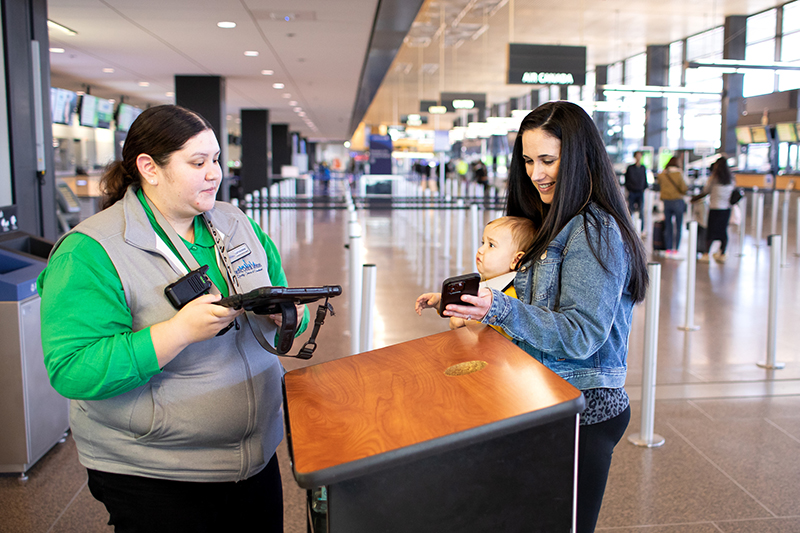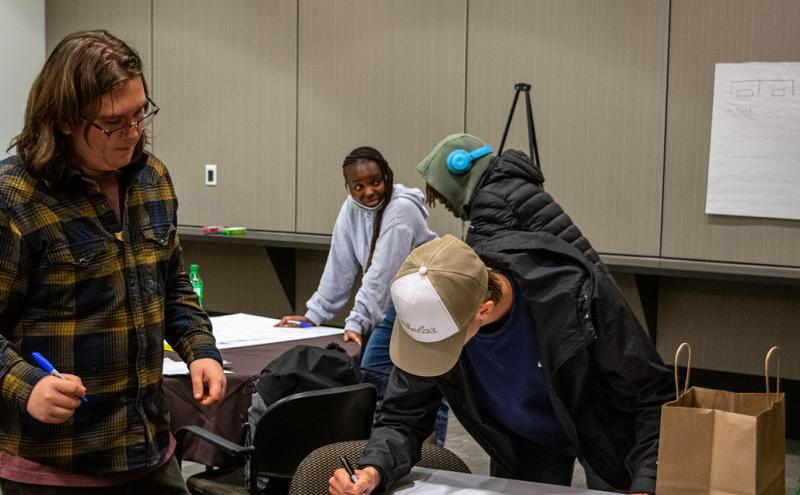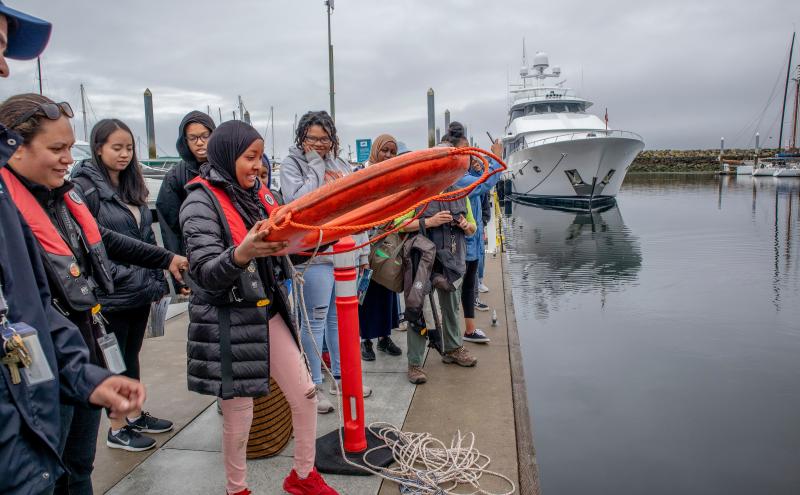
With upwards of 140,000 passengers flying in and out of Seattle-Tacoma International Airport (SEA) on busy days, the 4,000 square foot terminal transforms into the size of a small city. And with more people returning to travel after the pandemic, the airport is only getting busier.
To make travel as easy, comfortable, and predictable as possible, SEA looks for new ways to innovate and improve your airport journey from curb to gate. A key piece of that journey is providing a smooth security checkpoint experience that keeps you moving each step of the way.
Between 5,600 and 7,000 passengers pass through security lines an hour on any given day. Keeping lines moving is essential. Road bumps can occur when passengers reach the front of the checkpoint line and are waiting to go through security. Boarding passes and IDs must first be verified by TSA agents standing at podiums. This can cause confusion for passengers about where and when to line up, which can slow down security lines. Airport or TSA staff try to direct passengers during busy times, but staff are not always available.
To address this slowdown, SEA staff brought in outside help to brainstorm solutions to keep passengers moving and create a better experience in the checkpoint lines.

Real world challenge
The SEA Terminal Operations team decided they needed an outside perspective to help develop out of the box solutions. Led by SEA Capital Programs Senior Development Manager Dawson Frank, staff asked high school seniors enrolled in the Museum of Flight’s Aeronautical Science Pathway Program (ASP) to weigh in — a group that is passionate about aviation, travelers themselves, and the next generation of airport managers, pilots, and air traffic controllers. Students receive both high school and college credits through the program.
“We looked at this as a bigger picture,” Frank said. “We have a good relationship with the Boeing Academy for STEM Learning at the Museum of Flight. We thought we’d ask some creative young minds how we might approach the idea.”
Using the soon-to-be relocated and expanded Checkpoint 1 as a model, students were asked to problem solve traffic jams at the TSA checkpoint lines and how to create a faster and more efficient trip through the airport. Students got to apply their knowledge to real world problems and hone their presentation skills. And they learned about airport careers they might not have previously considered like managing terminal operations.
SEA staff worked with ASP Lead Instructor Robert Prosch to create and implement the challenge. The challenge launched with a security checkpoint tour at the airport and background on the challenge. Students spent the next few months developing proposed solutions that culminated in presentations to SEA staff at an event at the Museum of Flight.

Innovative solutions
Airport team members were impressed by the solutions proposed and the quality of the presentations.
“Students gave a consultant perspective on how to propose and build a project and asked a lot of technical questions. Every student group ended up incorporating a way to improve the customer experience in their proposal. Although the assignment was to approve efficiency, teams also wanted to make the passenger experience more enjoyable as well. They gave very good, in-depth presentations as a team, equivalent to what you’d see in the professional world,” Frank said.
SEA staff categorized each presentation by feasibility and maturity:
- Here now (or soon to be improved)
- Ready to implement
- Pilot program recommended
- Needs more research
- Not feasible
Learn more about some of the ideas developed by students or their suggestions for improving existing ideas and programs. You might see some of them now or soon at SEA Airport:
Here now
Digital signage
The next time you travel, keep an eye out for digital signs at the checkpoints (currently at Checkpoint 2). These digital boards help speed lines by providing important information like which lane to use, wait times, and instructions for entering the checkpoints. The students proposed different ways of utilizing digital signage to make it easier to see and more intuitive.
SEA Spot Saver
The popular checkpoint reservation system program SEA Spot Saver assigns a timed entry for the TSA security checkpoint line. Increasing participation in the program is an effective way to keep lines moving. We're telling everyone about this program through newsletters, QR code advertising on rental car and employee buses, our airline partners' check in email instructions, and even a new e-gate to get you through lines quickly. (Hint: you should try it).
Student suggestions for increasing use of the program included social media advertising, installing banners to advertise Spot Saver above the future Checkpoint 1, using digital signs to advertise Spot Saver at key locations in and around the checkpoints, and placing Spot Saver signage and QR codes on water disposal bins at the checkpoints.

New possibilities
The SEA team is researching or implementing the following student ideas.
Family/ADA Lane
Students recommended testing a dedicated lane for families and people needing Americans with Disabilities Act (ADA) assistance. Frank said that our TSA partners have implemented a pilot of this at Checkpoint 5 and are evaluating other locations.
Improved wayfinding
Plans to create color-coded wayfinding in the checkpoint lines — for example "follow the green line if you are a U.S. Citizen" — are in the works to help direct you to the proper line. It's similar to the colored route map on the SEA Underground train system.
Vibrating floors
One group of students proposed installing a vibrating plate in the floor that would shake once passengers reach the front of the security line to let them know to move to the next available position in line. Another group suggested making the whole floor around the checkpoints digital, with arrows on the ground directing passengers to the next step.
The airport team loved these ideas but the technology isn’t available yet, so they are working with a vendor to research other ways to get passengers’ attention in the security line. This includes testing the impact of lights next to the TSA podiums to alert passengers of the next available position.
Making checkpoints more exciting
Students also suggested ways to make the checkpoint lines more engaging for passengers. This closely matched the previous suggestions of an airport customer experience working group. The airport team is researching new ideas like installing art at the checkpoint, creating a living wall in the checkpoint area, and presenting trivia questions to people in line.
Win-win collaboration
Prosch said the project was a win-win-win for the Port, students, and the ASP program.
“For students, this is a career and technical education program that helps them understand what it’s like to work in the industry. It gave them a real-life example of work that airport management would be doing. A number of students are considering airport management because of this project,” Prosch said.
It’s a win for the Port because it provides an external focus group to provide out of the box thinking.
“It helps them think differently about how we can effectively and efficiently use portions of the terminal,” Prosch said.
It provides the ASP program with an opportunity to showcase students’ capabilities and interests in the field.
“It shows what ASP does to help students understand more about the industry, and provide real life examples. And highlights what we do with ASP and how we try to make this a real world program.”
Photo credit: All photos courtesy of the Museum of Flight.









